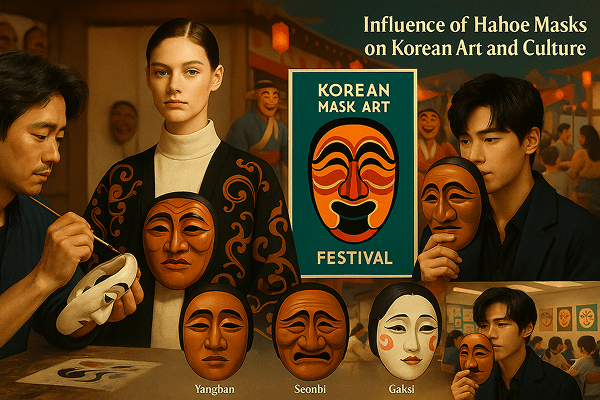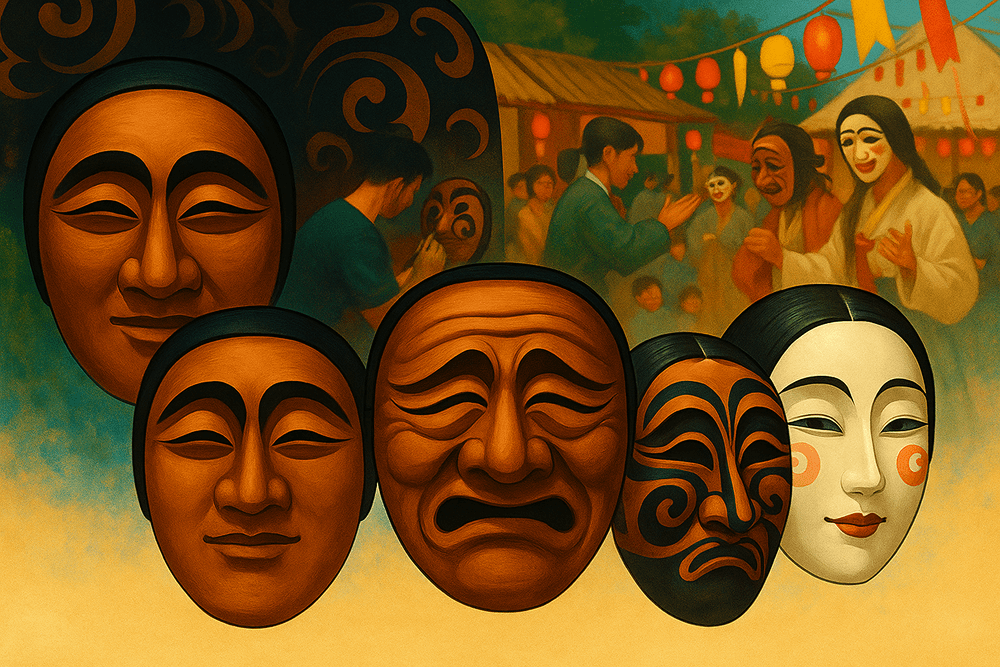Hahoe Masks are some of the most iconic and celebrated traditional masks from Korea, known both for their artistic craftsmanship and their central role in Korean cultural heritage. Originating in the historic village of Hahoe, near Andong in North Gyeongsang Province, these masks are distinguished by their expressive features, exaggerated facial expressions, and movable jaws. Hahoe Masks are primarily associated with the Hahoe Byeolsingut Talnori, a mask drama that blends satire, ritual, and folk theatre. Dating back several centuries, these masks are deeply woven into Korea’s social and spiritual fabric and are now recognized as Important Intangible Cultural Properties of South Korea.
Historical Origins
The history of Hahoe Masks is rich and layered, reflecting Korea’s long-standing tradition of mask drama and ritual performance. The name “Hahoe” (하회, pronounced ha-hoe) comes from the village where the masks originated—meaning “turning around the river,” a reference to the Nakdong River’s winding path around the settlement. The term “tal” (탈) simply means “mask” in Korean.
Scholars believe that the tradition of Hahoe masks emerged during the Goryeo Dynasty (918–1392), reaching its artistic peak in the early Joseon Dynasty (1392–1897). The earliest references to mask dances in the region appear in 12th-century historical documents, but the oldest surviving Hahoe masks are believed to date from the 16th century. These masks were used in annual village rituals to appease local spirits and ensure prosperity, as well as in satirical plays that critiqued social hierarchy and human folly.
Over time, the design and function of the masks evolved, influenced by shifting political, social, and religious contexts. While their role as ritual objects diminished with the decline of shamanic traditions, their theatrical function and artistic value have endured. Today, Hahoe Masks are considered masterpieces of Korean folk art and important symbols of regional identity.
Cultural Significance and Symbolism
Hahoe Masks carry profound symbolic weight in Korean culture. They are not just theatrical props but are seen as vessels of spiritual power, historical memory, and social commentary.
Symbolically, each mask represents a specific character from the Hahoe Byeolsingut Talnori drama, including the nobleman (Yangban), the scholar (Seonbi), the old woman (Halmi), the servant (Choraengi), the butcher (Baekjeong), the bride (Gaksi), and more. The exaggerated features and movable jaw—unique among Korean masks—allow performers to convey a wide range of emotions, from mockery to sorrow.
Spiritually, the masks were believed to embody the spirits of ancestors and local deities. In earlier times, they were used in exorcisms and shamanic rites to protect the village from misfortune and disease. The annual Hahoe Byeolsingut Talnori was performed as an offering to the village guardian spirit, blending Confucian, Buddhist, and indigenous beliefs.

Socially, the performance of the mask drama provided an opportunity for villagers to satirize the ruling elite, criticize social injustice, and celebrate communal values. Through humor and parody, the masks gave voice to the marginalized and reinforced the importance of harmony, resilience, and wit.
Materials and Craftsmanship
Hahoe Masks are crafted with exceptional artistry, using traditional materials and techniques that have been handed down through generations.
The primary material for Hahoe Masks is alder wood, chosen for its fine grain, durability, and lightness. The process begins by carefully selecting and seasoning the wood, which is then carved by hand using knives and chisels. The carver shapes the face, exaggerating features like the nose, mouth, and eyebrows to create expressive and dramatic effects.
A distinctive feature of many Hahoe Masks is the movable jaw, which is attached with leather or string and allows the performer to open and close the mouth during the drama. After carving, the mask is polished and painted with natural pigments, typically in earthy tones—red, brown, black, and white.
Decorative elements such as horsehair, cloth, or lacquer may be added to enhance the mask’s realism or symbolism. Regional variations in craftsmanship are subtle, but some masks display unique surface textures or patterns reflecting the individual style of the artisan.
Color symbolism is an important aspect of Hahoe Masks:
- Red is associated with vitality and good fortune.
- Black and brown denote age, wisdom, or sometimes villainy.
- White is used for purity or supernatural characters.
Functions and Uses
Hahoe Masks originally served both ritualistic and theatrical purposes. Their primary function was in the Hahoe Byeolsingut Talnori, a complex event that combined shamanic rites, communal prayers, and mask drama.
Hahoe Masks have been used in various contexts:
- Village rituals to appease guardian spirits and ensure prosperity.
- Theatrical performances satirizing the elite, exploring human nature, and teaching moral lessons.
- Festivals and celebrations, especially during the Lunar New Year and harvest season.
- Educational programs and cultural tourism in modern times.
- Museum exhibitions and contemporary art installations.

The use of Hahoe Masks has changed over time. While their original ritual function has largely faded, their role in folk theatre and cultural preservation continues to grow. Today, performances using Hahoe Masks are staged for both local audiences and international visitors, helping to keep the tradition vibrant and relevant.
Regional Variations
Although Hahoe Masks are most strongly associated with the village of Hahoe, mask drama traditions exist throughout Korea, each with unique local features.
Some key regional differences and comparisons include:
- Byeongsan Masks, from another village near Andong, have similar forms but different carving styles and character sets.
- Sandae Masks from Seoul and Gyeonggi Province display more elaborate decoration and are used in different comedic dramas.
- Talchum Masks from Hwanghae Province (now in North Korea) are noted for their grotesque shapes and satirical spirit.
Unlike the more stylized and abstract Noh masks of Japan or the brightly colored Chhau masks of India, Hahoe Masks are distinguished by their lifelike expressiveness, movable parts, and strong connection to communal ritual.
Famous Examples and Collections
Several original Hahoe Masks have survived for centuries and are now treasured national treasures. The most famous set, consisting of 11 masks, is designated as Korea’s National Treasure No. 121 and is preserved at the Andong Folk Museum. Individual masks, such as the Yangban (nobleman) and Gaksi (bride), are especially celebrated for their artistry.
Places to see authentic Hahoe Masks include:
- Andong Hahoe Folk Village, a UNESCO World Heritage site, where performances are still held.
- Andong Folk Museum, which displays historical masks and related artifacts.
- National Museum of Korea and regional museums.
- Online galleries and specialized collections, including those highlighted by toddmasks.com.
Private collectors and researchers also hold rare examples, some of which are occasionally exhibited in international exhibitions.
Influence on Art and Culture
Hahoe Masks have had a lasting influence on Korean art, literature, music, and design. Their expressive forms have inspired painters, sculptors, and contemporary visual artists. The themes of the mask dramas—satire, social commentary, and the interplay of fate and free will—have found echoes in Korean novels, films, and television dramas.
In modern design, Hahoe Mask motifs appear in fashion, graphic arts, and advertising. The masks are widely used as symbols of Korean identity, both at home and abroad, and play a central role in efforts to preserve and promote Korea’s intangible cultural heritage.

Educational programs, both in Korea and internationally, use Hahoe Masks to teach about performance, history, and creativity, while documentaries and cultural festivals help bring their story to a global audience.
Contemporary Status and Preservation
The tradition of Hahoe Mask making and performance is actively maintained by local artisans, cultural organizations, and government-supported programs. Contemporary masters continue to carve masks using traditional methods, passing on their skills through family lines and apprenticeships.
Preservation efforts include:
- Formal designation as Important Intangible Cultural Property.
- Government and NGO support for performances, research, and education.
- Integration into school curricula and community workshops.
- Contemporary adaptations, including new plays, multimedia installations, and collaborations with international artists.
Innovative programs, such as mask-making master classes and interactive exhibitions (featured on toddmasks.com), help ensure that the tradition remains vibrant and accessible to new generations.
Collecting and Acquiring
The market for Hahoe Masks ranges from affordable souvenirs to valuable antiques. Authentic, hand-carved masks by recognized artisans are highly prized by collectors and museums.
To acquire a genuine Hahoe Mask, consider the following:
- Purchase from reputable artisans in Andong or recognized galleries.
- Authentic masks are usually made from alder wood, with movable jaws and traditional finishing.
- Prices vary depending on age, craftsmanship, provenance, and artistic value.
- Seek documentation or expert appraisal to confirm authenticity.
- Be aware of ethical issues, including the importance of supporting living artisans and respecting cultural heritage.
For those interested in collecting, toddmasks.com offers guidance, background information, and access to curated selections.
